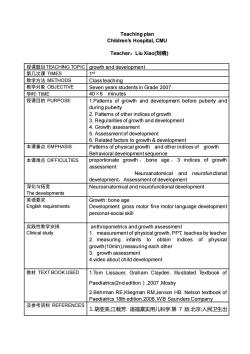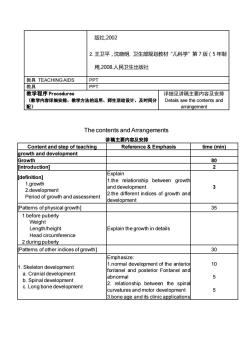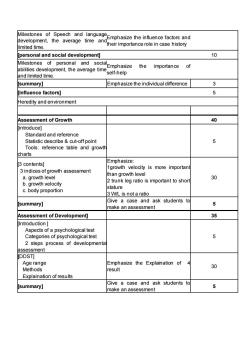《儿科学》课程教学资源(授课教案)02 Growth and Development

Teaching planChildren's Hospital, CMUTeacher:Liu Xiao(刘晓)授课题目TEACHINGTOPICgrowthanddevelopment第几次课TIMES1教学方法METHODSClass teaching教学对象OBJECTIVESeven years students in Grade 2007学时:TIME40×6minutes授课目的PURPOSE1.Patems of growth and development before puberty andduringpuberty2. Patterns of other indices of growth3.Regularitiesofgrowthanddevelopment4. Growth assessmentnent of developmentAS6. Related factors to growth & development本课重点EMPHASISPatterns of physical growth and otherindices of growthBehavioral development sequenceproportionate growth , bone age, 3 indices of growth本课难点DIFFICULTIESasssessmenNeuroanatomical and neurofunctionaldevelopment,Assessmentofdevelopment深化与拓宽NeuroanatomicalandneurofunctionaldevelopmentThe developments英语要求Growth: bone ageEnglish requirementsDevelopment: gross motor fine motor language developmentpersonal-social skill实践性教学安排anthropometrics and growth assessmentClinical study1. measurementof physical growth,PPT, teaches by teacher2.measuringinfantstoobtainindices of physicalgrowth(10min),measuring each other3.growthassessment4.video about child development教材TEXTBOOKUSED1.Tom Lissauer, Graham Clayden. Ilustrated Textbook ofPaediatrics(2nd edition),2007,Mosby2.Behrman RE,Kliegman RM,Jenson HB. Nelson textbook ofPaediatrics 18th edition,2008, W.B Saunders Company及参考资料REFERENCES1.胡亚美,江载芳.诸福棠实用儿科学.第7版.北京:人民卫生出
Teaching plan Children’s Hospital, CMU Teacher:Liu Xiao(刘晓) 授课题目TEACHING TOPIC growth and development 第几次课 TIMES 1 st 教学方法 METHODS Class teaching 教学对象 OBJECTIVE Seven years students in Grade 2007 学时: TIME 40×6 minutes 授课目的 PURPOSE 1.Patterns of growth and development before puberty and during puberty 2. Patterns of other indices of growth 3. Regularities of growth and development 4. Growth assessment 5. Assessment of development 6. Related factors to growth & development 本课重点 EMPHASIS Patterns of physical growth and other indices of growth Behavioral development sequence 本课难点 DIFFICULTIES proportionate growth , bone age , 3 indices of growth assessment Neuroanatomical and neurofunctional development,Assessment of development 深化与拓宽 The developments Neuroanatomical and neurofunctional development 英语要求 English requirements Growth: bone age Development: gross motor fine motor language development personal-social skill 实践性教学安排 Clinical study anthropometrics and growth assessment 1. measurement of physical growth, PPT, teaches by teacher 2. measuring infants to obtain indices of physical growth(10min),measuring each other 3. growth assessment 4.video about child development 教材 TEXT BOOK USED 1.Tom Lissauer, Graham Clayden. Illustrated Textbook of Paediatrics(2nd edition),2007 ,Mosby 2.Behrman RE,Kliegman RM,Jenson HB. Nelson textbook of Paediatrics 18th edition,2008, W.B Saunders Company 及参考资料 REFERENCES 1. 胡亚美,江载芳. 诸福棠实用儿科学.第 7 版.北京:人民卫生出

版社,20022.王卫平,沈晓明.卫生部规划教材"儿科学”第7版(5年制用,2008.人民卫生出版社教具TEACHINGAIDSPPT教具PPT教学程序Procedures详细见讲稿主要内容及安排(教学内容详细安排、教学方法的运用、师生活动设计、及时间分Details see the contents and配)arrangementThe contents and Arrangements讲稿主要内容及安排Content and step of teachingReference&Emphasistime (min)growthand developmentGrowth802[introduction]Explain[definition]1.the relationship between growth1.growthanddevelopment32.development2.the different indices of growth anPeriod of growth and assessmentIdevelopment[Patterns of physical growth]351before pubertyWeightLength/heightExplain the growth in detailsHead circumference2during puberty[Pattems of other indices ofgrowth]30Emphasize:101.normal development of the anterio1. Skeleton developmentfontanel andposteriorFontanel anga.Cranialdevelopmentabnormal5b.Spinaldevelopment2. relationship between the spin c. Long bone development5curvatures and motor development3.bone age and its clinic applications
版社,2002 2. 王卫平,沈晓明. 卫生部规划教材“儿科学”第 7 版(5 年制 用,2008.人民卫生出版社 教具 TEACHING AIDS PPT 教具 PPT 教学程序 Procedures (教学内容详细安排、教学方法的运用、师生活动设计、及时间分 配) 详细见讲稿主要内容及安排 Details see the contents and arrangement The contents and Arrangements 讲稿主要内容及安排 Content and step of teaching Reference & Emphasis time (min) growth and development Growth 80 [introduction] 2 [definition] 1.growth 2.development Period of growth and assessment Explain 1.the relationship between growth and development 2.the different indices of growth and development 3 [Patterns of physical growth] 35 1 before puberty Weight Length/height Head circumference 2 during puberty Explain the growth in details [Patterns of other indices of growth] 30 1. Skeleton development a. Cranial development b. Spinal development c. Long bone development Emphasize: 1.normal development of the anterior fontanel and posterior Fontanel and abnormal 2. relationship between the spinal curvatures and motor development 3.bone age and its clinic applications 10 5 5

Emphasize:2.Dental development1. delayederuption of Primar[a. Primary teeth 7teeth b. Permanent teeth2. abnormal dental development3.Sexual maturation3[Regularities ofgrowth]10it isa continuous&allometric process2.There are directional trendsJExplain the regularities by clini3.There are different rates in diferenexamlesissue4. There is individual difference80Behavioral development[Neuroanatomicand17neurofunctional developmentl1.Synapsis DevelopmentExplain the relationship between2.Myelination:afchild's behavior and immature of@ The peripheral NS is complete a'nervous system.birth(the sensation is mature).Emphasizethatmostbehaviorofan@The lower portions of CNS isisinfant directly depend on the brainlarge complete at birth development and only indirectly(hypermyotonia ,primitive reflexes).depend on environmental③The cerebral cortex is immatureat birthNewwords:(sleeptime,trendsofbehavi,cephalocaudal"hypermyotoniadevelopment cephalocaudal,proximodistalProximodistal[Sensoryandperceptual20 development)1.VisualdevelopmentExplain the expected performances2.Auditory developmentofandperceptualsensory 3.Taste and smell developmentdevelopment related to behavior4.Touch10[Gross motor development]Milestones ofgross motordevelopment,Emphasize the age is not ase average time and limited timeimportant as the progression5[Fine motor development]Milestones of fine motor development,Emphasizethehand-eyethe average time and limited time.coordination10[Speech and language development]
2.Dental development a. Primary teeth b. Permanent teeth Emphasize: 1. delayed eruption of Primary teeth 2. abnormal dental development 7 3.Sexual maturation 3 [Regularities of growth] 10 1.It is a continuous & allometric process 2.There are directional trends 3.There are different rates in different tissues 4. There is individual difference Explain the regularities by clinic examles Behavioral development 80 [Neuroanatomic and neurofunctional development] 17 1.Synapsis Development 2.Myelination: ① The peripheral NS is complete at birth (the sensation is mature). ② The lower portions of CNS is large complete at birth (hypermyotonia ,primitive reflexes). ③The cerebral cortex is immature at birth. (sleeptime, trends of behavior development : cephalocaudal, Proximodistal Explain the relationship between child's behavior and immature of nervous system. Emphasize that most behavior of an infant directly depend on the brain development and only indirectly depend on environmental New words: hypermyotonia ,cephalocaudal, proximodistal [Sensory and perceptual development] 20 1.Visual development 2.Auditory development 3.Taste and smell development 4.Touch Explain the expected performances of sensory and perceptual development related to behavior [Gross motor development] 10 Milestones of gross motor development, the average time and limited time. Emphasize the age is not as important as the progression [Fine motor development] 5 Milestones of fine motor development, the average time and limited time. Emphasize the hand-eye coordination [Speech and language development] 10

Milestones of Speech and languageEmphasize the influence factors anoEevelopment, theaverageime andmimporanceroleincasehislimited time.10[personal and social development]Milestones of personal andsocialmphasizetheimportance01andlimitedtimeEmphasize theindividual difference3[summary][influence factors]5Heredity and environment40AssessmentofGrowth[introduce]Standard and reference5Statistic describe & cut-off pointTools: reference table and growthchartsEmphasize[3contents]1growth velocity is more importan3 indices of growth assessmentthan growth level30a. growth level2 trunkleg ratio is important to shortb. growth velocitystaturec. body proporion3 WIL is not a ratioGive a case and ask students to5ummary]make an assessment35Assessment of Development][Introduction]Aspects of a psychological test5Categories of psychological test 2 steps process of developmentaassessment[DDST]AgerangeEmphasize the Explaination of30MethodsresultExplaination of resultsGive a case and ask students to[summary]5make an assessment
Milestones of Speech and language development, the average time and limited time. Emphasize the influence factors and their importance role in case history [personal and social development] 10 Milestones of personal and social abilities development, the average time and limited time. Emphasize the importance of self-help [summary] Emphasize the individual difference 3 [influence factors] 5 Heredity and environment Assessment of Growth 40 [introduce] Standard and reference Statistic describe & cut-off point Tools: reference table and growth charts 5 [3 contents] 3 indices of growth assessment a. growth level b. growth velocity c. body proportion Emphasize: 1growth velocity is more important than growth level 2 trunk leg ratio is important to short stature 3 W/L is not a ratio 30 [summary] Give a case and ask students to make an assessment 5 Assessment of Development] 35 [Introduction ] Aspects of a psychological test Categories of psychological test 2 steps process of developmental assessment 5 [DDST] Age range Methods Explaination of results Emphasize the Explaination of 4 result 30 [summary] Give a case and ask students to make an assessment 5

总结及补充修正授课年级备注总结及修正补充内容1st class
总结及补充修正 授课年级 总结及修正补充内容 备注 1 st class
按次数下载不扣除下载券;
注册用户24小时内重复下载只扣除一次;
顺序:VIP每日次数-->可用次数-->下载券;
- 《儿科学》课程教学资源(授课教案)03 Nutrition During Childhood.doc
- 《儿科学》课程教学资源(授课教案)09 Haematopoiesis and Blood Cell Counts.doc
- 《儿科学》课程教学资源(授课教案)08 Congenital Heart Disease.doc
- 《儿科学》课程教学资源(授课教案)06 Hypoxic-ischemic Encephalopathy.doc
- 《儿科学》课程教学资源(授课教案)07 Bronchopneumonia.doc
- 《儿科学》课程教学大纲 Teaching Outline for Pediatrics Course(英文).pdf
- 《临床生物化学》课程教学资源(PPT课件)第十九章 自动临床生物化学分析仪的应用及评价.ppt
- 《临床生物化学》课程教学资源(PPT课件)第十八章 治疗药物浓度监测.ppt
- 《临床生物化学》课程教学资源(PPT课件)第十七章 妊娠的生物化学检验.ppt
- 《临床生物化学》课程教学资源(PPT课件)第十六章 肿瘤标志物的生物化学检验.ppt
- 《临床生物化学》课程教学资源(PPT课件)第十五章 神经系统疾病的生物化学检验.ppt
- 《临床生物化学》课程教学资源(PPT课件)第十四章 消化系统疾病的生物化学检验.ppt
- 《临床生物化学》课程教学资源(PPT课件)第十三章 内分泌疾病的生物化学检测.ppt
- 《临床生物化学》课程教学资源(PPT课件)第十二章 心血管系统疾病的生物化学检测.ppt
- 《临床生物化学》课程教学资源(PPT课件)第十一章 肾功能损伤的生物化学检验.ppt
- 《临床生物化学》课程教学资源(PPT课件)第十章 肝胆疾病的生物化学检验.ppt
- 《临床生物化学》课程教学资源(PPT课件)第九章 营养状况的评估及的生物化学监测.ppt
- 《临床生物化学》课程教学资源(PPT课件)第八章 微量元素与维生素异常的生物化学检验.ppt
- 《临床生物化学》课程教学资源(PPT课件)第七章 骨代谢紊乱及相关元素的生物化学检验.ppt
- 《临床生物化学》课程教学资源(PPT课件)第六章 电解质和酸碱平衡紊乱的生物化学检验.ppt
- 《儿科学》课程教学资源(授课教案)05 Neonatal Septicemia.doc
- 《儿科学》课程教学资源(授课教案)04 Neonatal Jaundice.doc
- 《儿科学》课程教学资源(授课教案)01 Introduction of Pediatrics.doc
- 《儿科学》课程教学资源(授课教案)25 Scarlet Fever.doc
- 《儿科学》课程教学资源(授课教案)23 Infantile Hepatitis Syndrome.doc
- 《儿科学》课程教学资源(授课教案)22 Infantale Diarrhea and Fluid Therapy.doc
- 《儿科学》课程教学资源(授课教案)24 Mumps.doc
- 《儿科学》课程教学资源(授课教案)18 Primary Pulmonary Tuberculosis.doc
- 《儿科学》课程教学资源(授课教案)21 Chronic Gastritis in Children.doc
- 《儿科学》课程教学资源(授课教案)20 Toxic Bacillary Dysentery.doc
- 《儿科学》课程教学资源(授课教案)19 Tuberculosis Meningitis.doc
- 《儿科学》课程教学资源(授课教案)16 Measles.doc
- 《儿科学》课程教学资源(授课教案)17 Varicella.doc
- 《儿科学》课程教学资源(授课教案)14 Congenital Hypothyroidism.doc
- 《儿科学》课程教学资源(授课教案)15 Growth Hormone Deficiency.doc
- 《儿科学》课程教学资源(授课教案)10 Nutritional Iron Deficiency Anemia.doc
- 《儿科学》课程教学资源(授课教案)13 Immunodeficiency.doc
- 《儿科学》课程教学资源(授课教案)11 Acute Convulsion in Children.doc
- 《儿科学》课程教学资源(授课教案)12 Acute Glomerulonephritis,Nephrotic Syndrome.doc
- 《儿科学》课程作业习题(复习题)08 questions of immune system.doc
